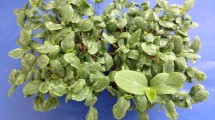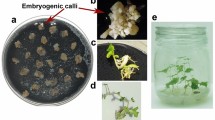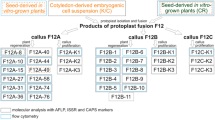Abstract
Mosaic (MSC) mutants of cucumber (Cucumis sativus L.) appear after passage through cell cultures. The MSC phenotype shows paternal transmission and is associated with mitochondrial DNA rearrangements. This review describes the origins and phenotypes of independently produced MSC mutants of cucumber, including current knowledge on their mitochondrial DNA rearrangements, and similarities of MSC with other plant mitochondrial mutants. Finally we propose that passage of cucumber through cell culture can be used as a unique and efficient method to generate mitochondrial mutants of a higher plant in a highly homozygous nuclear background.
Similar content being viewed by others
References
Bartoszewski G, Katzir N, Havey MJ, 2004a. Organization of repetitive DNAs and the genomic regions carrying ribosomal RNA,cob, andatp9 genes in the cucurbit mitochondrial genomes. Theor Appl Genet 108: 982–992.
Bartoszewski G, Malepszy S, Havey MJ, 2004b. Mosaic (MSC) cucumbers regenerated from independent cell cultures possess different mitochondrial rearrangements. Curr Genet 45: 45–53.
Barwale UB, Widholm JM, 1987. Somaclonal variation in plants regenerated from culture of soybean. Plant Cell Rep 6: 365–368.
Baszczyk-Guzek A, Szwacka M, 1994. Selection and characterization of salt-tolerant cucumber (Cucumis sativus L.) plants usingin vitro culture. Cucurbit Gen Coop Rep 17: 40–49.
Buiatti M, Marcheschi G, Tognoni F, di Pada ML, Grenci FC, Martini G, 1985. Genetic variability induced by tissue culture in the tomato (Lycopersicon esculentum). Z Pflanzenzuchtg 94: 162–165.
Burza W, Malepszy S, 1995a. Direct plant regeneration from leaf explants in cucumber (Cucumis sativus L.) is free of stable genetic variation. Plant Breeding 114: 341–345.
Burza W, Malepszy S, 1995b.In vitro culture ofCucumis sativus L. XVII. Plants from protoplasts through direct somatic embryogenesis. Plant Cell Tiss Organ Cult 41: 259–266.
Burza W, Malepszy S, 1998. Cytokinin control of cucumber (Cucumis sativus L.) somatic embryogenesis. In: Altman A, ed. Plant Biotechnology and InVitro Biology in the 21st Century. Proceedings of the IX IAPTC International Congress on Plant Tissue and Cell Culture, Jerusalem, June 14–19, 1998: 68.
Chétrit P, Rios R, De Paepe R, Vitart V, Gutierres S, Vedel F, 1992. Cytoplasmic male sterility is associated with large deletions in the mitochondrial DNA of twoNicotiana sylvestris protoclones. Curr Genet 21: 131–137.
Clifton SW, Minx P, CM Fauron, Gibson MJO, Allen H, Sun M, et al. 2004. Sequence and comparative analysis of the maize NB mitochondrial genome Plant Physiol 136: 3486–3503.
Day A, Ellis THN, 1985. Deleted forms of plastid DNA in albino plants from cereal anther culture. Curr Genet 9: 671–678.
De Paepe R, Chétrit P, Vitart F, Ambart-Bretteville F, Prat D, Vedel F, 1990. Several nuclear genes control both male sterility and mitochondrial protein synthesis inNicotiana sylvestris protoclones. Mol Gen Genet 222: 206–210.
Dörfel P, Weihe A, Knösche R, Börner T, 1989. Mitochondrial DNA ofChenopodium album L.: a comparison of leaves and suspension cultures. Curr Genet 16: 375–380.
Ducos E, Touzet P, Boutry M, 2001. The male sterile G cytoplasm of wild beet displays modifield mitochondrial respiratory complexes. Plant J 26: 171–180.
Evans DA, Sharp WR, 1983. Single gene mutations in tomato plants regenerated from tissue cultures. Science 221: 949–951.
Fauron CR, Moore B, Casper M, 1995. Maize as a model of higher plant mitochondrial genome plasticity. Plant Sci 112: 11–32.
Hanson MR, Conde MF, 1985. Functioning and variation of cytoplasmic genomes: lessons from cytoplasmic-nuclear interactions affecting male fertility in plants. Int Rev Cytol 94: 214–267.
Harada T, Sato T, Asaka D, Matsukawa I, 1991. Large-scale deletions of rice plastid DNA in anther culture. Theor Appl Genet 81: 157–161.
Hartmann C, De Buyser J, Henry Y, Falconet D, Lejeune B, Benslimane AA, et al. 1987. Time-course of mitochondrial genome variation in wheat embryogenic somatic tissue cultures. Plant Sci 53: 191–198.
Hartmann C, Henry Y, Treagear J, Rode A, 2000. Nuclear control of mitochondrial genome reorganization characterized using cultured cells of ditelosomic and nullisomic-tetrasomic wheat lines. Curr Genet 38: 156–162.
Hauschner H, Yesodi V, Izhar S, Tabib Y, Firon N, 1998. Cytoplasmic diversity caused by mitochondrial (mt) DNA dynamics and mt gene expression in petunia. In: Altman A, ed. Plant Biotechnology andIn Vitro Biology in the 21st Century. Proceedings of the IX IAPTC International Congress on Plant Tissue and Cell Culture, Jerusalem, June 14–19, 1998: 147–150.
Havey MJ, 1997. Predominant paternal transmission of the cucumber mitochondrial genome. J Hered 88: 232–235.
Havey MJ, McCreigh JD, Rhodes B, Taurick G, 1998. Differential transmission of theCucumis organellar genomes. Theor Appl Genet 97: 122–128.
Havey MJ, Park YH, Bartoszewski G, 2004. ThePsm locus controls paternal sorting of cucumber mitochondrial genome. J Hered 95: 492–497.
Hunt MD, Newton KJ, 1991. The NCS3 mutation, genetic evidence for the expression of protein 14 genes inZea mays mitochondria. EMBO J 10: 1045–1052.
Kanazawa A, Tsutsumi N, Hirai A, 1994. Reversible changes in the composition of the population of mtDNAs during dedifferentiation and regeneration in tobacco. Genetics 138: 865–870.
Kaeppler SM, Kaeppler HF, Rhee Y, 2000. Epigenetic aspects of somaclonal variation in plants. Plant Mol Biol 43: 179–188.
Kaeppler SM, Phillips RL, 1993. Tissue culture-induced DNA methylation variation in maize. Proc Natl Acad Sci USA 90: 8773–8776.
Karp A, 1991. On the current understanding of somaclonal variation. Oxford Surveys of Plant Mol Cell Biol 7: 1–58.
Kubo N, Nishizawa S, Sugawara A, Itchoda N, Estiati A, Mikami T, 2000. The complete nucleotide sequence of the mitochondrial genome of sugar beet (Beta vulgaris L.) reveals a novel gene for tRNACys (GCA). Nucleic Acids Res 28: 2571–2576.
Kuzmin EV, Duvick DN, Newton KJ, 2005. A mitochondrial mutator system in maize. Plant Physiol 137: 779–789.
Ladyżyński M, Burza W, Malepszy S, 2002. Relationship between somaclonal variation and type of culture in cucumber. Euphytica 125: 349–356.
Larkin PJ, Scowcroft WR, 1981. Somaclonal variation — a novel source of variability from cell cultures for plant improvement. Theor Appl Genet 60: 197–214.
Lelandais C, Albert B, Gutierres S, De Paepe R, Godelle B, Vedel F, Chetrit P, 1998. Organization and expression of the mitochondrial genome in theNicotiana sylvestris CMSII mutant. Genetics 150: 873–882.
Li XQ, P Chétrit, Mathieu C, Vedel F, De Paepe R, Remy R, Ambard-Bretteville F, 1988. Regeneration of cytoplasmic male sterile protoclones ofNicotiana sylvestris with mitochondrial variations. Curr Genet 13: 261–266.
Lilly JW, Havey MJ, 2001. Small repetitive DNAs contribute significantly to the expanded mitochondrial genome of cucumber. Genetics 159: 317–328.
Lilly JW, Bartoszewski G, Malepszy S, Havey MJ, 2001. A major deletion in the mitochondrial genome sorts with MSC phenotype of cucumber. Curr Genet 40: 144–151.
Malepszy S, Nadolska-Orczyk A, 1989.In vitro culture ofCucumis sativus. VIII. Variation in the progeny of phenotypically not altered R1 plants. Plant Breed 102: 66–72.
Malepszy S, Burza W, Śmiech M, 1996. Characterization of a cucumber (Cucumis sativus L.) somaclonal variation with paternal inheritance. J Appl Genet 37: 65–78.
Martinez-Zapater JM, Gil P, Capel J, Somerville CHR, 1992. Mutations at theArabidopsis CHM locus promote rearrangements of the mitochondrial genome. Plant Cell 4: 889–899.
Marienfeld JR, Newton KJ, 1994. The maize NCS2 abnormal growth mutant has a chimericnad4- nad7 mitochondrial gene and is associated with reduced complex I function. Genetics 138: 855–863.
Newton KJ, Gabay-Laughnan S, De Paepe R, 2004. Mitochondrial mutations in plants. In: Day DA, Millar AH, Whelan J, eds. Plant mitochondria: from genome to function. Advances in photosynthesis and respiration, Vol. 17. Dordrecht, The Netherlands: Kluwer Academic Publishers: 121–142.
Newton KJ, Knudsen C, Gabay-Laughnan S, Laughnan JR, 1990. An abnormal growth mutant in maize has a defective mitochondrial cytochrome oxidase gene. Plant Cell 2: 107–113.
Notsu Y, Masood S, Nishikawa T, Kubo N, Akiduki G, Nakazono M, 2002. The complete sequence of the rice (Oryza sativa L.) mitochondrial genome: frequent DNA sequence acquisition and loss during the evolution of the flowering plants. Mol Gen Genet 268: 434–445.
Ogihara Y, Yamazaki Y, Murai K, Kanno A, Terachi T, Shiina T, et al. 2005. Structural dynamics of cereal mitochondrial genomes as revealed by complete nucleotide sequencing of the wheat mitochondrial genome. Nucleic Acids Res 33: 6235–6250.
Oono K, 1978. High frequency mutations in rice plants regenerated from seed callus. In: Thorpe TA, ed. Proceedings of the Fourth International Congress of Plant Cell and Tissue Culture, Univ. of Calgary Press. Calgary, Canada: 52.
Palmer JD, Herbon LA, 1988. Plant mitochondrial DNA evolves rapidly in structure, but slowly in sequence. J Mol Evol 28: 87–97.
Pląder W, Malepszy S, Burza W, Rusinowski Z, 1998. The relationship between the regeneration system and genetic variability in the cucumber (Cucumis sativus L.). Euphytica 103: 9–15.
Pupilli F, Labombarda P, Arcioni S, 2001. New mitochondrial genome organization in three interspecific somatic hybrids ofMedicago sativa including the parent-specific amplification of substoichiometric mitochondrial DNA units. Theor Appl Genet 103: 927–978.
Rousell DL, Thompson DL, Pallardy SG, Miles D, Newton KJ, 1991. Chloroplast structure and function is altered in the NCS2 maize mitochondrial mutant. Plant Physiol 96: 232–238.
Sakamoto W, Kondo H, Murata M, Motoyoshi F, 1996. Altered mitochondrial gene expression in a maternal distorted leaf mutant ofArabidopsis induced by chloroplast mutator. Plant Cell 8: 1377–1390.
Shirzadegan M, Christey M, Earle ED, Palmer JD, 1989. Rearrangement amplification, and assortment of mitochondrial DNA molecules in cultured cells ofBrassica campestris. Theor Appl Genet 77: 17–25.
Skirvin RM, McPheeters KD, Norten M, 1994. Source and frequency of somaclonal variation. Hort Sci 29: 1232–1237.
Unseld M, Marienfeld JR, Brandt P, Brennicke A, 1997. The mitochondrial genome ofArabidopsis thaliana contains 57 genes in 366,924 nucleotides. Nature Genet 15: 57–61.
Vitart V, de Paepe R, Mathieu C, Chétrit P, Vedel F, 1992. Amplification of substoichiometric recombinant mitochondrial DNA sequences in a nuclear male sterile mutant regenerated from protoplast culture inNicotiana sylvestris. Mol Gen Genet 233: 193–200.
Ward BL, Anderson RS, Bendich AJ, 1981. The mitochondrial genome is large and variable in a family of plants (Cucurbitaceae). Cell 25: 793–803.
Ziółkowska A, Bartoszewski G, Burza W, Kuraś M, Pląder W, Malepszy S, 2005. Mitochondrial mutant MSC cucumber shows impaired somatic embryogenesis. Plant Cell Tiss Org Cult 80: 329–338.
Author information
Authors and Affiliations
Corresponding author
Rights and permissions
About this article
Cite this article
Bartoszewski, G., Havey, M.J., Ziółowska, A. et al. The selection of mosaic (MSC) phenotype after passage of cucumber (Cucumis sativus L.) through cell culture — a method to obtain plant mitochondrial mutants. J Appl Genet 48, 1–9 (2007). https://doi.org/10.1007/BF03194652
Received:
Accepted:
Issue Date:
DOI: https://doi.org/10.1007/BF03194652




